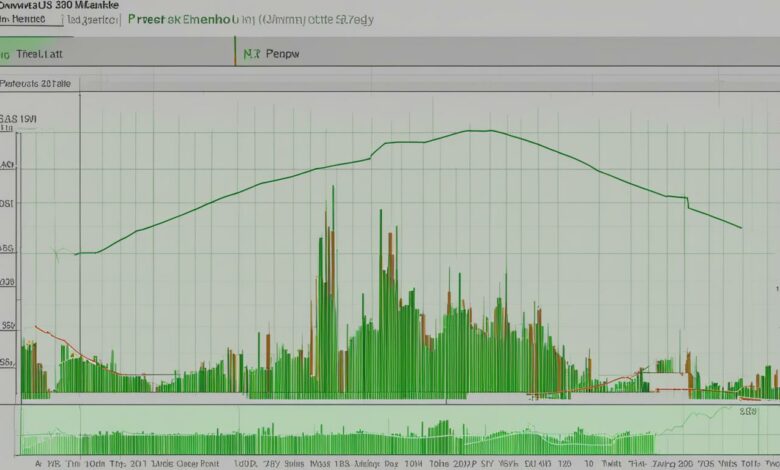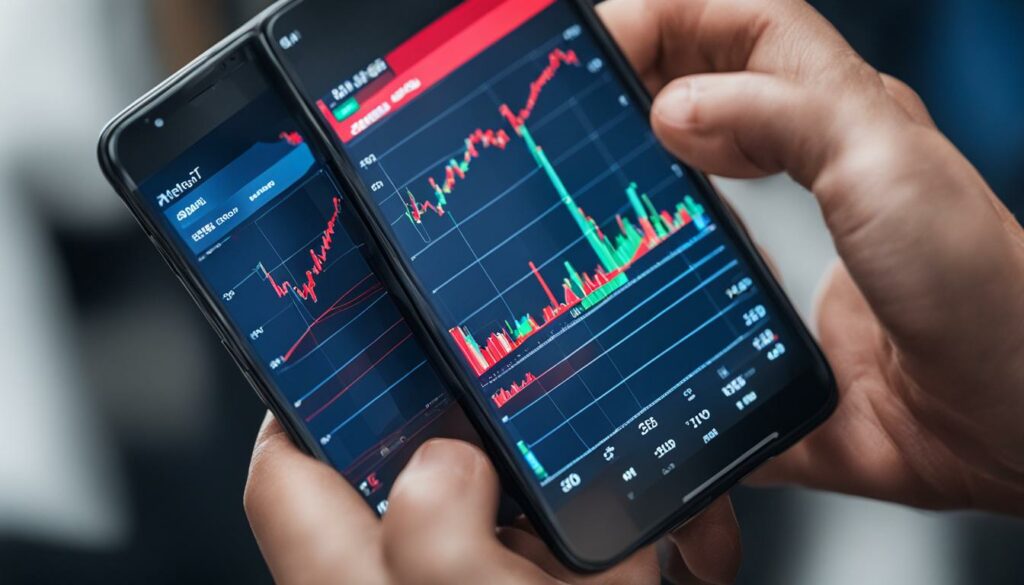Risk Off: Protective Put for Volatile Markets

The protective put options strategy is a valuable tool for investors looking to protect their portfolios against market volatility. It provides downside protection and acts as a form of portfolio insurance. By purchasing stock and buying put options on a share-for-share basis, investors can safeguard their portfolios against potential losses. The protective put strategy is particularly useful during bearish short-term forecasts but bullish long-term forecasts, as it allows investors to limit their risk while still participating in the potential upside of the stock market.
When implementing a protective put strategy, investors need to carefully consider factors such as the cost of the put options, the expiration date, and the strike price. These elements play a crucial role in determining the level of protection and the potential impact of market fluctuations. Analyzing market conditions, including implied volatility and time decay, is also essential to maximize the effectiveness of the protective put.
While the protective put strategy offers several benefits, including portfolio protection and peace of mind, there are also potential risks and downsides to consider. The cost of purchasing put options adds to the overall investment cost, and in certain market scenarios, the protective put may provide limited protection. Investors must evaluate their individual goals, risk tolerance, and market outlook to determine if a protective put is the right strategy for them.
Key Takeaways:
- The protective put options strategy provides downside protection and limits losses during market downturns.
- It allows investors to participate in the upside potential of the stock market while safeguarding their portfolios.
- Factors such as the cost of put options, expiration date, and strike price should be carefully considered when setting up a protective put.
- Market elements such as implied volatility and time decay can impact the effectiveness of a protective put.
- Investors may need to adjust or exit their protective put positions based on changing market conditions.
Understanding the Concept of a Protective Put
A protective put is a strategy that involves buying stock and purchasing put options as a form of insurance. When the stock price declines, the put option provides protection by allowing the investor to sell the stock at the strike price. This strategy is used to limit losses and protect against market downturns.
By understanding the concept of a protective put, investors can effectively implement this strategy and safeguard their portfolios. The protective put acts as a safety net, allowing investors to mitigate potential losses and navigate volatile markets with confidence.
“A protective put is like having an insurance policy for your stock holdings. It provides a level of security and peace of mind in the face of market uncertainty.”
– Financial Pro
What sets a protective put apart from other strategies is that it allows investors to participate in the upside potential of the stock, while still providing downside protection. This means that even if the stock price increases, investors can benefit from the upward movement while having the assurance of protection if the stock price declines.
Understanding the Benefits
One of the key benefits of a protective put is its ability to limit losses during market downturns. This strategy helps to preserve capital and protect against significant declines in the stock price. Additionally, the protective put gives investors peace of mind and allows them to actively manage their portfolios, making informed decisions based on their market outlook.

| Benefits | Explanation |
|---|---|
| Downside Protection | A protective put provides a level of security against potential losses in a volatile market. |
| Participation in Upside Potential | Investors can still benefit from stock price increases while having protection in case of a decline. |
| Capital Preservation | A protective put helps to limit losses and preserve capital during market downturns. |
| Proactive Portfolio Management | Investors can actively manage their portfolios and make informed decisions based on their outlook. |
Setting up a Protective Put
Setting up a protective put involves a few key steps to ensure the strategy is implemented effectively. Here are the essential factors to consider when setting up a protective put:
- Identify the stock: Choose the stock for which you want to set up a protective put. This can be an existing stock position or a new purchase.
- Purchase shares: Buy shares of the stock at the current market price. The number of shares will depend on the desired level of protection and the investor’s risk tolerance.
- Select the put options: Purchase put options on a share-for-share basis. The strike price of the put options should be below the current market price of the stock, providing downside protection.
- Analyze expiration date: Consider the expiration date of the put options. It is important to choose an expiration date that aligns with the investor’s forecast and the desired timeframe for protection.
- Evaluate costs: Take into account the cost of the put options, including the premium and any associated commissions. This cost should be factored into the overall investment decision.
By following these steps, investors can initiate a protective put and minimize potential losses during market downturns. It is crucial to carefully analyze the factors involved and consider the potential impact on the protective put strategy.
Factors to Consider when Setting up a Protective Put
When setting up a protective put, there are several factors that investors should carefully consider:
- Risk tolerance: Determine the level of risk tolerance and the desired level of protection. This will help determine the number of shares and the strike price of the put options.
- Costs: Evaluate the costs associated with purchasing the put options. Consider the premium and any commissions to ensure the strategy aligns with your overall investment budget.
- Expiration date: Choose an expiration date that aligns with your forecast and timeframe for protection. The expiration date should provide adequate time for the protective put to remain in effect.
- Market conditions: Assess the current market conditions and the potential impact on the stock price. Consider factors such as volatility and industry trends.
By taking these factors into account, investors can make informed decisions when setting up a protective put strategy and effectively protect their portfolios against market volatility.
The Impact of Market Elements on a Protective Put
In order to fully understand the effectiveness and dynamics of a protective put strategy, it is crucial to consider the impact of various market elements. These factors can significantly influence the outcome of the strategy and the potential returns for investors. Key market elements that have a noteworthy impact on a protective put strategy include time decay and implied volatility.
The Effect of Time Decay on a Protective Put
Time decay refers to the erosion of the time value of an option as it approaches its expiration date. This decay occurs at an accelerated rate as the expiration date draws nearer. For a protective put strategy, time decay can have a significant impact on its profitability. As time passes, the value of the put option decreases due to the diminishing time remaining until expiration. This means that if the stock price remains relatively stable or increases, the protective put strategy may result in a loss as the value of the put option declines. It is important for investors to carefully consider the impact of time decay and the timing of their protective put strategy in order to maximize its effectiveness.
Understanding the Influence of Implied Volatility on a Protective Put
Implied volatility is a measure of the market’s expectation of potential future price fluctuations of the underlying stock. It plays a significant role in determining the value of an option, including the put option used in a protective put strategy. When implied volatility is high, the value of the put option increases, providing greater potential profits for the protective put strategy. Conversely, when implied volatility is low, the value of the put option decreases, resulting in lower potential returns for the strategy. It is crucial for investors to understand the influence of implied volatility and consider it when evaluating the potential profitability of a protective put strategy.
By carefully analyzing the impact of market elements, such as time decay and implied volatility, investors can make informed decisions about when and how to implement a protective put strategy. These elements can significantly affect the profitability and effectiveness of the strategy, and understanding their influence is crucial for successful implementation. It is important to stay updated with market trends and factors that can impact a protective put in order to make informed investment decisions.

Strategies for Adjusting and Exiting a Protective Put
When it comes to the protective put options strategy, knowing when and how to adjust or exit your positions is crucial for maximizing its effectiveness. Market conditions and your forecast play a significant role in determining the appropriate strategies for adjusting and exiting your protective put.
One common strategy for adjusting a protective put is to sell the put option and keep the stock position unprotected. This can be suitable if you believe that the market conditions have improved, and the likelihood of a significant decline in the stock price has diminished. By selling the put option, you can free up capital and potentially realize a profit if the put option has appreciated in value.
Another strategy is to sell the put option and purchase another put option with a further expiration date to extend the protection. This strategy is suitable if you still have concerns about potential downside risk but believe that the current put option has limited remaining value. By buying another put option, you can maintain protection for an extended period while managing the cost of the strategy.
“The key is to adjust your protective put strategy based on your forecast and risk tolerance.”
Alternatively, you may choose to exercise the put option and sell the stock. This strategy is suitable if you believe that the stock price will continue to decline significantly and you want to lock in your gains or limit your losses. By exercising the put option, you can sell the stock at the predetermined strike price and exit the position.
Market volatility also plays a crucial role in determining your exit strategy. If market volatility increases significantly, you may consider adjusting or exiting your protective put to protect against potential losses. On the other hand, if market volatility decreases, you may decide to adjust your protective put to free up capital or reduce the cost of the strategy.
Strategies for Adjusting and Exiting a Protective Put:
- Sell the put option and keep the stock position unprotected if market conditions improve.
- Sell the put option and buy another put option with a further expiration date to extend protection.
- Exercise the put option and sell the stock if you believe the stock price will continue to decline significantly.
Remember, the key is to adjust your protective put strategy based on your forecast and risk tolerance. Evaluating market conditions, managing the cost of the strategy, and considering the impact of market volatility will help you make informed decisions when adjusting or exiting your protective put positions.
Benefits of Using a Protective Put Strategy
A protective put strategy offers several benefits to investors. First and foremost, it provides downside protection during market downturns. By purchasing put options, investors have the right to sell their stock at a pre-determined strike price, thereby limiting potential losses and ensuring the preservation of capital. This can be especially valuable in volatile markets where stock prices can fluctuate significantly.
Furthermore, the protective put strategy allows investors to participate in the upside potential of the stock, less the cost of the put. This means that if the stock price increases, investors can still profit from the appreciation, while having the peace of mind knowing that their downside risk is limited. This combination of potential gains and downside protection makes the protective put strategy an attractive option for investors looking to manage risk.
“The protective put strategy provides investors with a proactive approach to portfolio management. By using this strategy, investors can take control of their investments and actively protect against potential losses. It allows us to navigate volatile markets with confidence.”
Finally, the protective put strategy offers investors the ability to be proactive in their portfolio management. By having a protective put in place, investors can act quickly to limit losses and adjust their positions as market conditions change. This flexibility can be invaluable in uncertain times when market volatility is high. By using a protective put strategy, investors can have greater control over their investment outcomes and make informed decisions based on their individual goals and risk tolerance.
Overall, the protective put strategy provides a comprehensive approach to risk management. It offers downside protection, allows for potential gains, and enables proactive portfolio management. By carefully considering the benefits and drawbacks of the strategy, investors can determine whether it aligns with their investment goals and risk appetite. In volatile markets, the protective put strategy can be a valuable tool for navigating uncertainties and protecting portfolio value.

Table: Potential Risks and Downsides of Using a Protective Put
| Risks and Downsides | Description |
|---|---|
| Increased Investment Cost | Purchasing put options adds to the overall investment cost, potentially reducing overall returns. |
| Possible Loss of Premium | If the stock price does not decline, the put option may expire worthless, resulting in a loss of the premium paid. |
| Limited Protection in Extreme Market Downturns | A protective put may provide limited protection in highly volatile and rapidly declining markets. |
Timing the Use of a Protective Put in a Volatile Market
Choosing the right timing to implement a protective put strategy in a volatile market is crucial for maximizing its effectiveness. To determine the best time to use a protective put, there are several factors to consider:
- The overall market conditions: In a volatile market with high levels of uncertainty and increased volatility, it may be a suitable time to initiate a protective put. These conditions often indicate a higher probability of market downturns.
- Individual stock positions: Evaluate the potential downside risk of your specific stock holdings. If you have concerns about a particular stock’s performance or the overall industry outlook, it may be a good time to consider implementing a protective put.
- Technical analysis and market indicators: Utilize technical analysis tools and market indicators to identify trends, support, and resistance levels. This can help determine optimal entry points for a protective put strategy.
By carefully analyzing these factors, investors can make informed decisions on when to initiate a protective put strategy in a volatile market, enhancing their potential for downside protection.
Example Quote:
“Timing is everything when it comes to a protective put in a volatile market. By assessing market conditions, evaluating individual stock positions, and utilizing technical analysis, investors can determine the best time to implement this strategy.” – Financial Advisor

| Factors to Consider | Importance |
|---|---|
| Market Conditions | High |
| Individual Stock Positions | Moderate |
| Technical Analysis and Market Indicators | Moderate |
Table: Factors to Consider When Determining the Best Time to Use a Protective Put in a Volatile Market
Determining the Right Strike Price and Expiration Date
When it comes to implementing a protective put option strategy, determining the right strike price and expiration date is crucial. These factors will directly impact the level of protection and the effectiveness of your overall strategy. Here are some considerations to keep in mind when determining the right strike price and expiration date for your protective put option.
- Evaluate your desired level of protection: The strike price of the put option should be chosen based on the level of downside risk you want to protect against. A lower strike price will provide more protection but come at a higher cost, while a higher strike price may offer less protection but come with a lower premium.
- Consider your investment timeframe: The expiration date of the put option should align with your investment timeframe and outlook. If you anticipate a short-term market downturn, a shorter expiration date may be more appropriate. On the other hand, if you expect a longer-term bearish trend, a longer expiration date may be preferable.
- Analyze historical price patterns: Studying historical price patterns can provide insights into past market behavior and help you make more informed decisions. Look for patterns that indicate potential support levels or resistance areas that could influence the choice of strike price and expiration date.
- Utilize technical analysis: Technical analysis tools and indicators can help you gauge market sentiment and identify potential price targets. By incorporating technical analysis into your decision-making process, you can better assess the optimal strike price and expiration date for your protective put option.
By carefully considering these factors and conducting thorough analysis, you can determine the right strike price and expiration date for your protective put option. Remember that the choice of strike price and expiration date should align with your risk tolerance, investment goals, and market outlook. Consulting with a financial advisor can also provide valuable guidance and help you make well-informed decisions.

Example Table: Comparison of Strike Prices and Expiration Dates
| Strike Price | Expiration Date | Risk Tolerance |
|---|---|---|
| $100 | 3 months | Low |
| $90 | 6 months | Medium |
| $80 | 12 months | High |
This table provides a hypothetical example comparing different strike prices and expiration dates based on varying levels of risk tolerance. The choice of strike price and expiration date should be tailored to your individual circumstances and risk appetite.
Is a Protective Put the Right Strategy for You?
When considering investment strategies in a volatile market, it’s important to assess whether a protective put is the right strategy for you. Determining the suitability of this strategy depends on factors such as your goals, risk tolerance, and market outlook. Let’s explore some key considerations to help you make an informed decision.
1. Financial Objectives: Consider your financial objectives and investment goals. Are you looking for capital preservation or are you willing to take on potential losses in pursuit of higher returns? Understanding your financial objectives will help you assess whether a protective put aligns with your overall investment strategy.
2. Risk Tolerance: Evaluate your risk tolerance. Are you comfortable with potential losses or do you prefer a more conservative approach? A protective put provides downside protection, but it also comes with the cost of purchasing put options. Consider how much risk you are willing to tolerate and whether the potential benefits outweigh the drawbacks.
3. Market Outlook: Assess your market outlook. How do you anticipate market conditions in the near future? If you foresee increased market volatility or anticipate a potential downturn, a protective put can help mitigate potential losses. However, if you have a positive long-term outlook and believe the market will rebound, a protective put may not be necessary.
| Considerations | Protective Put Strategy | Alternative Strategies |
|---|---|---|
| Capital Preservation | Provides downside protection | No specific protection |
| Potential Losses | Limits losses | Potential for higher losses |
| Market Downturns | Reduces impact of downturns | No specific protection |
| Market Upside | Participate in the upside potential | Full participation |
Ultimately, the decision to employ a protective put strategy should align with your financial goals, risk tolerance, and market outlook. Consulting with a financial advisor can provide valuable insights into the suitability of a protective put for your specific circumstances. By carefully evaluating these factors, you can determine whether a protective put is the right strategy for you in a given market.

Key Takeaways:
- Evaluate your financial objectives, risk tolerance, and market outlook before deciding on a protective put strategy.
- Consider the potential benefits and drawbacks, such as capital preservation and limited losses versus the cost of purchasing put options.
- Assess your market outlook and determine if a protective put aligns with your forecast.
- Consult with a financial advisor to gain personalized advice and insights.
Conclusion
In conclusion, the protective put options strategy is a powerful tool for investors looking to safeguard their portfolios in volatile markets. It provides downside protection and limits potential losses during market downturns, allowing investors to navigate uncertain times with confidence.
By purchasing stock and buying put options on a share-for-share basis, investors can protect against potential losses while still participating in the upside potential of the stock. However, it is important to carefully consider the potential risks and downsides, such as the cost of purchasing the put options and the limited protection in extreme market conditions.
To effectively implement a protective put strategy, investors should consider factors such as market elements, timing, strike price, and expiration date. By conducting thorough analysis and leveraging technical indicators, investors can determine the optimal conditions for initiating and adjusting their protective put positions.
In summary, the protective put options strategy is a valuable tool that can help investors mitigate risk and protect their portfolios in volatile markets. However, it is crucial to consider the individual investor’s goals, risk tolerance, and market outlook before deciding if this strategy is the right fit. Consulting with a financial expert can provide additional guidance and insights to enhance the effectiveness of a protective put strategy.
FAQ
What is a protective put?
A protective put is a strategy that involves buying stock and purchasing put options as a form of insurance. When the stock price declines, the put option provides protection by allowing the investor to sell the stock at the strike price.
How does a protective put protect against losses?
A protective put provides downside protection below the strike price and lasts until expiration. It allows investors to limit losses during market downturns by selling the stock at the strike price, which is higher than the market price.
What factors should I consider when setting up a protective put?
Factors to consider include the cost of the put options, the expiration date, and the strike price. It is important to carefully analyze these factors and consider the potential impact of market elements on the protective put.
How does time decay impact a protective put?
Time decay refers to the erosion of the time value of the put option as it approaches expiration. This can affect the profitability of the protective put strategy, as the value of the put option decreases over time.
What are some strategies for adjusting and exiting a protective put?
Investors can adjust or exit their protective put positions by selling the put and keeping the stock position unprotected, selling the put and buying another put to extend the protection, or exercising the put and selling the stock. The decision depends on the investor’s forecast and their desire to hold the stock.
What are the benefits of using a protective put strategy?
The protective put strategy provides downside protection, limits losses during market downturns, and allows investors to participate in the upside potential of the stock, less the cost of the put. It also provides peace of mind and allows proactive portfolio management.
What are the potential risks and downsides of using a protective put?
The cost of purchasing the put options adds to the overall investment cost, and if the stock price does not decline, the put option may expire worthless, resulting in a loss of the premium. Additionally, the protective put may only provide limited protection in extreme market downturns.
How can I determine the best time to use a protective put in a volatile market?
Timing is crucial when using a protective put strategy in a volatile market. Investors should consider overall market conditions, such as high levels of volatility, and evaluate their individual stock positions and potential downside risk. Technical analysis and market indicators can help determine the best time to implement a protective put.
How can I determine the right strike price and expiration date for my protective put option?
The strike price should be chosen based on the investor’s desired level of protection and the potential downside risk. The expiration date should align with the investor’s forecast and timeframe. Analyzing historical price patterns and using technical analysis can help in determining the optimal strike price and expiration date.
How can I determine whether a protective put is the right strategy for me in a given market?
Whether a protective put is the right strategy for an investor depends on their individual goals, risk tolerance, and market outlook. It is important to evaluate the potential benefits and drawbacks of a protective put strategy and assess whether it aligns with their overall investment strategy. Consulting with a financial advisor can also provide valuable insights.







